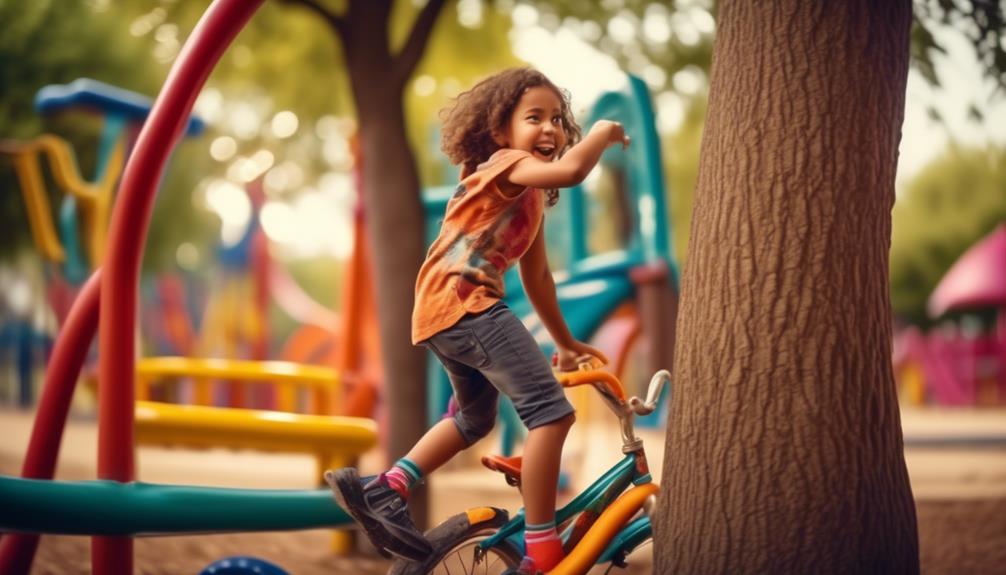How to Support Your Child's Physical Development

Ways to support your child's physical development include:
- Encouraging active playtime
- Nurturing fine motor skills
- Building strength
- Promoting a healthy lifestyle
Implementing these strategies can lay the foundation for a strong and vibrant future for your child.
Key Takeaways
- Encourage active playtime and outdoor exploration to promote physical development.
- Nurturing fine motor skills through activities like puzzles and playdough can enhance coordination.
- Create a healthy diet and nutrition plan to support overall growth and well-being.
- Lead by example and practice healthy eating habits as a family to positively influence your child's choices.
Importance of Physical Development
Physical development is a crucial aspect of your child's growth, supporting their overall health and well-being as they navigate the world around them. As a parent, you play a vital role in promoting the importance of physical health and encouraging your child to engage in regular physical activity.
Physical health isn't just about the absence of illness or disease; it encompasses the well-being of the whole body. When your child engages in physical activity, it helps strengthen their muscles and bones, improves their cardiovascular health, and enhances their immune system. Regular physical activity also reduces the risk of chronic conditions such as obesity, diabetes, and heart disease.
But the benefits of physical activity go beyond just physical health. It can also have a positive impact on your child's mental and emotional well-being. Exercise releases endorphins, the feel-good hormones, which can boost your child's mood, reduce stress, and improve their overall mental health. It can also enhance their cognitive abilities, including memory, attention span, and problem-solving skills.
Developmental Milestones to Look for
Now, let's talk about the important developmental milestones you should be looking for as your child grows. These milestones serve as guideposts, indicating that your child is progressing in their physical development.
From rolling over to crawling, and eventually walking and running, each milestone is a stepping stone towards their physical independence.
Key Milestones to Track
As your child grows, there are important developmental milestones to track that can provide insights into their physical development. These milestones serve as a guide to ensure your child is progressing as expected.
Here are some key milestones to look out for:
- Gross Motor Skills: Watch for your child's ability to roll over, sit up without support, crawl, and eventually walk. Encourage age-appropriate activities like tummy time to strengthen their muscles.
- Fine Motor Skills: Pay attention to your child's ability to grasp objects, pick up small items, and manipulate toys. Offer activities that promote hand-eye coordination, such as stacking blocks or coloring.
- Balance and Coordination: Observe how your child maintains balance and coordination while playing and moving. Engage them in activities like riding a tricycle or playing catch to enhance these skills.
- Physical Strength: Notice your child's muscle development and strength. Encourage activities that require them to climb, jump, or swing to improve overall physical strength.
Encouraging Physical Activities
As you track your child's key milestones, it's important to also focus on encouraging physical activities that support their overall development. Providing them with opportunities for both indoor activities and outdoor exploration is crucial for their growth and well-being.
Indoor activities can include games like hide-and-seek or dancing to their favorite music. These activities not only help your child develop their gross motor skills but also promote creativity and imagination.
On the other hand, outdoor exploration allows them to engage with nature and experience the world around them. Taking them to the park, going for walks, or even just playing in the backyard can provide them with endless opportunities to run, jump, and climb, which are essential for their physical development.
Encouraging Active Playtime
To encourage your child's physical development, it's important to prioritize active playtime. Engaging in physical activities not only helps your child stay fit but also aids in the development of their gross motor skills.
Here are some fun and exciting ways to encourage active playtime for your little one:
- Outdoor Adventures: Take your child to the park or playground where they can run, jump, climb, and explore. Encourage them to try different activities like playing catch, riding a bike, or even just taking a nature walk.
- Indoor Fun: On days when the weather doesn't cooperate or if you prefer staying indoors, there are still plenty of options for active playtime. Set up an obstacle course in the living room, play a game of hide-and-seek, or have a dance party where your child can move and groove to their favorite tunes.
- Sports and Games: Introduce your child to various sports and games that promote physical activity. Whether it's soccer, basketball, swimming, or even simple games like tag or Simon says, these activities won't only keep them active but also teach them valuable skills like coordination and teamwork.
- Family Bonding: Make active playtime a family affair! Plan outings or activities that involve the whole family, such as hiking, cycling, or playing a game of backyard football. Spending quality time together while being physically active is a win-win situation for everyone.
Nurturing Fine Motor Skills
Developing fine motor skills in your child is crucial for their overall development and can be nurtured through various activities and exercises. Fine motor skills involve the coordination of small muscles in the hands and fingers, allowing your child to perform tasks like writing, buttoning clothes, and using utensils. By encouraging and supporting the development of these skills, you're helping your child build the foundation for future success.
One way to nurture fine motor skills is by promoting hand-eye coordination activities. These activities help your child improve their ability to use their eyes to guide their hand movements. Simple games like throwing and catching a ball, playing with building blocks, or completing puzzles can all contribute to the development of hand-eye coordination.
Another important aspect of fine motor skill development is the pincer grip, which is the ability to hold small objects between the thumb and index finger. This grip is essential for tasks like picking up small objects, using scissors, and writing. You can support the development of the pincer grip by providing your child with opportunities to practice activities that require the use of their fingers, such as threading beads, playing with playdough, or using tweezers to pick up objects.
Incorporating these activities into your child's daily routine can help them master fine motor skills and enhance their overall development. Remember to be patient and encouraging as they practice these skills, as it takes time and effort to strengthen their coordination and dexterity.
Creating a Healthy Diet and Nutrition Plan
Now that you've laid the foundation for your child's fine motor skill development, it's time to shift gears and focus on creating a healthy diet and nutrition plan.
Good nutrition is essential for your child's overall physical development and well-being. By instilling healthy eating habits and providing balanced nutrition, you're setting them up for a lifetime of good health.
Here are four key points to consider when creating a healthy diet and nutrition plan for your child:
- Variety is key: Encourage your child to try a wide range of fruits, vegetables, whole grains, and lean proteins. This will provide them with the essential nutrients they need for growth and development.
- Limit processed foods: Processed foods tend to be high in added sugars, unhealthy fats, and sodium. Instead, opt for freshly prepared meals and snacks whenever possible.
- Hydration is important: Make sure your child drinks plenty of water throughout the day. Water helps to keep their body hydrated and supports proper digestion and nutrient absorption.
- Lead by example: Children are more likely to adopt healthy eating habits if they see their parents practicing them. Be a role model by choosing nutritious foods and eating them together as a family.
Building Strength and Endurance
As your child continues to grow, it's important to focus on building their strength and endurance through fun and engaging activities. Building flexibility and cardiovascular health are key aspects of their physical development. Encouraging your child to engage in activities that promote these skills won't only benefit their overall health but also boost their confidence and self-esteem.
One great way to build strength and endurance is through regular exercise. Encourage your child to participate in activities such as running, swimming, or cycling. These activities not only strengthen their muscles but also improve their cardiovascular health. Additionally, they're fun and allow your child to enjoy the outdoors while staying active.
Another way to promote strength and endurance is through activities that focus on building flexibility. Yoga and stretching exercises are excellent choices for improving flexibility and enhancing muscle strength. These activities not only increase your child's range of motion but also help prevent injuries.
Safety Measures for Physical Activities
When it comes to your child's physical activities, safety should always be a top priority. There are several important measures you can take to ensure their well-being.
First, make sure to follow equipment safety guidelines to minimize the risk of accidents.
Second, provide constant supervision and monitoring during their activities to prevent any potential injuries.
Lastly, don't forget the importance of proper warm-up routines to prepare their bodies and prevent strains or sprains.
Equipment Safety Guidelines
To ensure a safe and enjoyable physical activity experience for your child, it's crucial to follow equipment safety guidelines. Here are some key points to keep in mind:
- Regular equipment maintenance: Regularly inspect the equipment your child uses for any signs of wear and tear. Replace any damaged or broken parts immediately to prevent accidents.
- Proper fitting: Ensure that the equipment, such as helmets, pads, and shoes, fits your child properly. Ill-fitting equipment can be uncomfortable and ineffective in preventing injuries.
- Supervision: Always supervise your child when they're using equipment, especially if they're younger or inexperienced. This way, you can step in if any safety issues arise.
- Instruction and training: Teach your child how to properly use the equipment and provide them with the necessary training. This will help them develop the skills and knowledge needed to engage in physical activities safely.
Supervision and Monitoring
Ensure the safety and well-being of your child during physical activities by providing adequate supervision and monitoring. As a parent, it's crucial to establish clear supervision guidelines to keep your child safe while they engage in various physical activities.
First and foremost, always be present and attentive when your child is participating in physical play. Keep an eye on them to prevent any accidents or injuries. Additionally, make sure the environment is safe by removing any potential hazards or obstacles. Set boundaries and establish rules to guide your child's behavior and ensure their safety.
Moreover, employ effective monitoring techniques such as staying within sight and hearing distance, especially when they're playing outdoors or in unfamiliar surroundings.
Proper Warm-Up Routines
Start off your child's physical activities on the right foot by incorporating proper warm-up routines for their safety and optimal performance. Warm-up techniques are essential in preparing the body for physical exertion and reducing the risk of injury. Here are four important warm-up techniques to implement:
- Dynamic stretching: Encourage your child to perform controlled movements that mimic the actions they'll be doing during their activity. This helps to increase blood flow and flexibility.
- Cardiovascular exercises: Get their heart rate up with light jogging, jumping jacks, or skipping. This increases blood circulation and warms up the muscles.
- Joint mobility exercises: Focus on movements that target the major joints, such as shoulder rolls or ankle circles. This helps to lubricate the joints and improve range of motion.
- Sport-specific warm-up drills: Incorporate drills that mimic the movements used in the specific sport or activity your child will be participating in. This helps to prepare their muscles for the specific demands of the activity.
Frequently Asked Questions
How Can I Help My Child Develop Good Posture and Balance?
You can support your child's physical development by promoting good posture and improving balance. By encouraging activities like yoga or dance, you can help them develop strong muscles and coordination for better posture and balance.
What Are Some Fun Activities I Can Do With My Child to Promote Physical Development?
Looking for fun activities to promote physical development? Try engaging in outdoor games like tag or soccer, or get active indoors with exercises like dance parties or obstacle courses. Let's get moving and have some fun together!
Are There Any Specific Toys or Equipment That Can Help Improve My Child's Fine Motor Skills?
To improve your child's fine motor skills, there are many toys and equipment you can use. These tools help them develop hand-eye coordination and dexterity. Additionally, exercises for posture and balance can be incorporated into their daily routine.
How Can I Ensure That My Child Is Getting Enough Physical Activity During the School Day?
To ensure your child gets enough physical activity during the school day, encourage them to be more active at home. Incorporate physical activity into their daily routine, like playing outside or going for family walks.
What Are Some Safety Precautions I Should Take When My Child Is Participating in Organized Sports or Recreational Activities?
When it comes to sports safety and injury prevention, it's crucial to take precautions for your child. Make sure they have the right protective gear, stay hydrated, warm up properly, and listen to their body.











